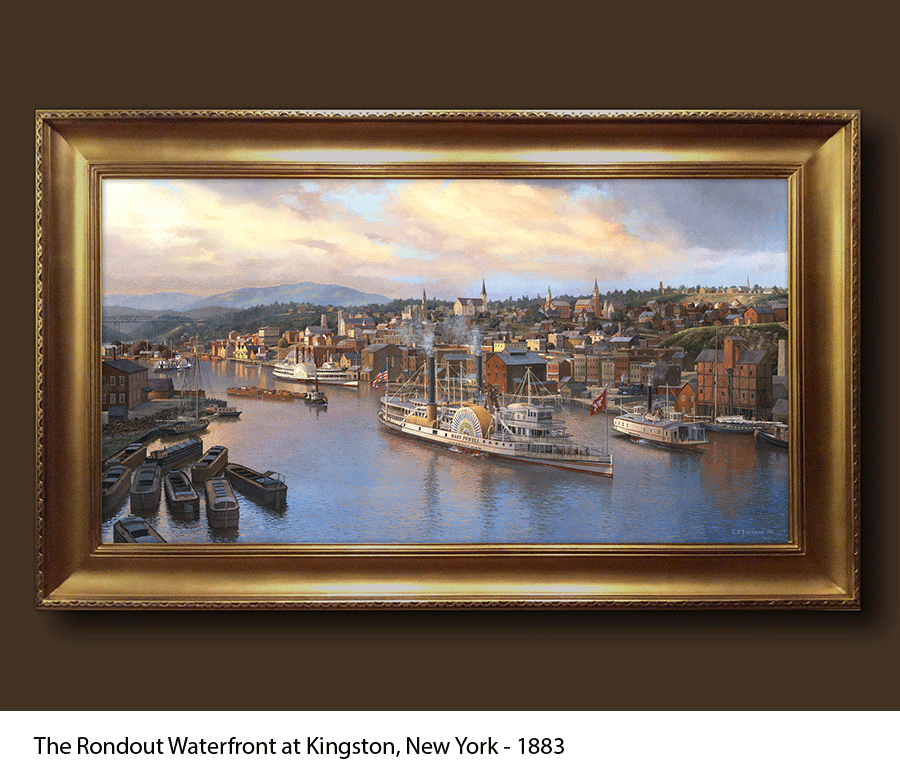Reconstructing History in Paint
- by Bruce E. McKinney

At some point, for serious institutions and collectors the reimagining of the past becomes essential to understanding and explaining it. Today’s assumptions are often, if not always, very different from what was reality in those now receding decades.
Re-imaging is also fraught with issues. The quality of the research and the balanced evaluation of underlying resources becomes essential to separating what we think from what reality really was. In every case such efforts are interpretative.
This issue is being directly addressed in a series of paintings by the gifted artist, L. F. Tantillo, who is reimaging the mid-Hudson Valley in the 19th century.
The first painting in this 8 painting series was issued in 2018, a reconstruction of what was the most significant fire in the history of New Paltz at the school that would in time become the State University at New Paltz. The 1906 fire destroyed one institution from whose ashes a new one, less than a mile away, on a larger campus emerged in 1909, to become a gem in the New York State university system today. An image of that painting is attached.
The second painting, now complete, reimagines Rondout, New York circa 1883. This once separate community, now incorporated into Kingston, Ulster’s county seat, portrays its waterfront at the confluence of the Rondout Creek, Wallkill and Hudson Rivers. The Delaware & Hudson Canal, then in decline, empties its cargo barges arriving from the coal fields in Pennsylvania onto larger ships at Rondout to be towed south to New York City. In the distance, carried across on a bridge running north and south, railroads, successors to the declining canal system, spring into precarious life, their glory to be brief for the car and truck within 20 years would begin to move passengers and cargo into cars and trucks.
Meanwhile, preparing to depart, the Mary Powell, then Queen of the Hudson River steamboats, prepares to carry passengers and cargo to New York City in a desperate, but ultimately losing battle with the railroads that would carry the cargos and passengers there and far beyond to distant places faster and at lower cost.
The evolution of transportation would play out in Ulster County as it would across the country, battles fought to advance progress, prestige and money literally in real time as fortunes were made and lost. These things happened elsewhere but, in Ulster, they were determinative for as their fortunes rose and fell, so too did the prosperity of the region.
Ulster County, was at that moment in 1883, for a brief second in the clock of cosmic time, very close to the center of the New England economic revolution. It wouldn’t last, but, in its moment, it was grand. This painting reminds us that success is fleeting, even pyrrhic.
The third painting, of 8 in this series now under consideration, may capture the fading glory of Poughkeepsie as seen from the then wonder of the world, the immense Hudson River Railroad Bridge around the turn of the 20th century when trollies from New Paltz could reach the bridge to carry passengers across to Poughkeepsie. Alternatively, a scene capturing the epic grandeur of Lake Awosting on the Shawangunk Mountain ridge line or a moment-in-time perspective of the region’s historically most important surviving enterprise, Lake Mohonk Mountain House, are being considered. In time it is hoped that all these and three other perspectives will be painted, to in time become The Ulster County Cycle.